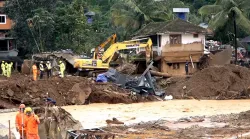Why do landslides occur and what are the susceptible regions in India? Explained
Kerala, Himachal Pradesh, Uttarakhand and Maharashtra witnessed landslides amidst monsoon this year. Here are some of the reasons of why landslides occur and what are some of the most landslide-prone regions in the country.

The frequency of landslides in India and fatalities due to them have seen a spike this year. Currently, Kerala's Wayanad, Himachal Pradesh, Uttarakhand and other states are currently reeling from the effects of landslides. With the worst devastation, landslides in Kerala claimed over 300 while hundreds are missing. One of the well-known and widely acknowledged reasons for frequent landslides is the intensifying climate change. But there are more factors, that contribute to the occurrence of landslides.
Factors causing landslide
- Geological factor: It means the characteristics of the material. The rocks and soil have their own strength and stiffness that make them less or more prone to landslides
- Morphological factor: This means the structure of land. Simply put, the loss of vegetation can make soil loose and vulnerable to landslides while the rich flora reduces the chances of landslides. So, deforestation is also an essential cause of landslides in hilly areas.
- Heavy rains: The torrential rains can trigger landslides. This is one of the most prominent reasons and its impact is visible. The rains increase the pore water pressure of the soil due to which slope load increases and landslide gets triggered
- Anthropogenic activity: Human activities such as construction, agriculture and irrigation also contribute to the causes of landslides. These activities destabilise and weaken the slope making it prone to landslides.
Regions susceptible to landslides in India
According to a team of IIT Madras, that has worked on landslides and has developed a high-resolution India Landslide Susceptibility Map (ILSM) and published a paper in the institute's 'Shaastra' magazine, India accounts for 8 per cent of total fatalities due to landslides. It argues that landslides were only given importance after the 2013 Kedarnath landslides and floods. Through their map ILSM, the team found that 13.17 per cent of the country is susceptible to landslides and 4.75 per cent is 'very highly susceptible'.
Talking about states, Sikkim has the most susceptible land area at 57.6 per cent. Outside the Himalayas, Kerala is most vulnerable to landslides with over 14 per cent of its land area being ‘very highly susceptible." Additionally, some areas in the Eastern Ghats, mostly around Odisha, are also susceptible to landslides, which the research team argues that previous studies missed. In terms of area, Arunachal Pradesh has the most landslide-prone territory with an extensive stretch of 31,845 sq km. According to the study, previous research missed it because of the littleness of incidents.
ALSO READ | Wayanad landslide: Kerala Forest Department officials rescue 6 tribals, including 4 children